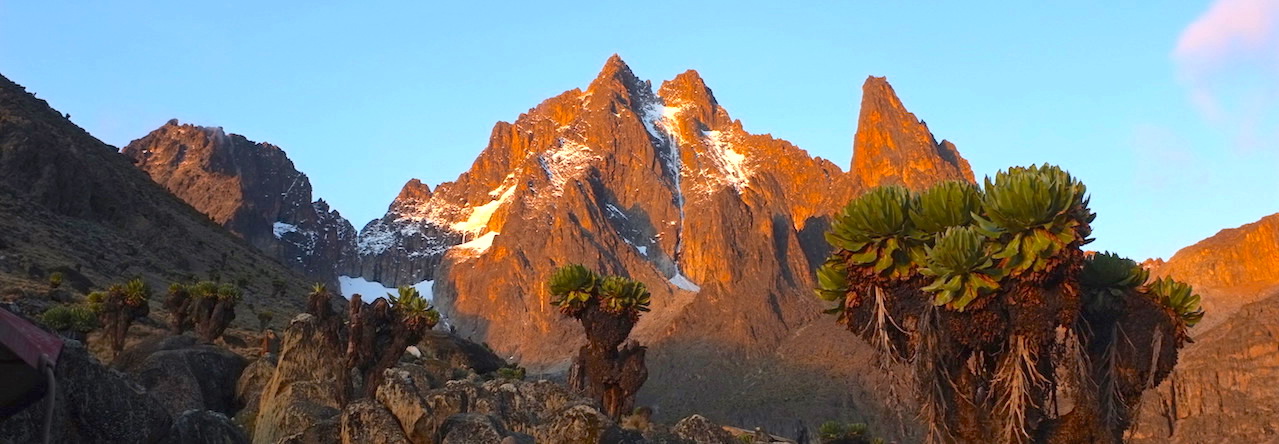This trip is a two‐day traverse covering the southern end of the Aberdares Park that is rarely done in
recent years. Following up on an adventurous trip by Alex involving airplanes assisting with navigation in
the forest and other colorful tales, the club attempted the traverse. The first attempt was fun but rained
out below Kinangop. Then a small club group (Jeff and Florian) completed the hike last year. The hike
passes over two peaks: The Elephant and Kinangop. It starts from the Njabini (formerly called South
Kinangop) Forest Station and ends at the Mitubio Park Gate on the West side of the Aberdares Park.
We will meet at Njabini Forest Station on Friday afternoon at 5 PM and camp at the trail head on the
forest road so that we can get an early start on Saturday morning. The forest station is only 1.5 hours
from Nairobi. Four wheel drives are not required to reach the station, but will be required to reach the
trail head. Cars can be parked safely at the forest station. We can ferry those who don’t have four wheel
drive to the trail head. Directions will be sent later.
On day 1, the goal will be to reach the ridge and camp 50 meters below the summit of Kinangop
Mountain. The trail starts out in the bamboo forest and climbs into open ridge as it reaches the summit of
The Elephant (3591m). The trail is very obvious up to the summit of The Elephant.
Figure 1: Trail on the ridge to the The Elephant
From The Elephant, the trail descends dramatically (200m) to the moorlands between The Elephant and
Kinangop Mountain. The trail is less distinct in this area, but moves along the principal ridge. In this
region, mists are common and use of GPS for navigation has been necessary in the past.
Midway to Kinangop, a semi‐permanent water source should be flowing at this time of year with
excellent water. Depending on the weather, other sources may be available higher up. It should be
obvious from the prevailing conditions, if water is available higher up.
Figure 2: The Climb to Kinangop Peak – The furthest peak is the main peak – The twelve apostles on the
ridge to the right
We will start to climb from this point up to the ridge with the Kinangop peaks. The main peak is just
below 4000 meters and is a rocky out crop requiring a bit of scrambling from the open moorlands. We
will camp on the moorlands just below this summit at about 3900 meters. The night will be cold and
appropriate sleeping bags, hats, gloves and jackets are required. Last time, ice formed on the top of the
water in our jerry can.
Figure 3: From Kinangop Summit looking back along the summit ridge at The Elephant – note the descent
from The Elephant to the lower ridge between the two peaks.
Figure 4: A view of Mount Kenya form Kinangop Ridge
One the second day, we will proceed down the ridge to the North in the direction of Mutubio Gate. We
will be in open country with an obvious trail for 2 hours. Then we will enter the bamboo forest and
traverse three smaller hills in the course of the day. In our last trip, we followed an obvious line following
the highest points on the West side of the Aberdares plateau using remanents of an old trial marked on
the map and game trails.
Figure 5: The hike follows the ridge through the forest over the three small hills to Mutubio Gate
We have a GPS track for our previous route and will be able to improve on this route. This mid‐section of
the hike requires good route finding even on bright sunny days! As we traverse the last hill, the train
becomes distinct and leads us to the gate through mixed brush and open country. As we have a GPS track,
we should be able to complete this day in 7 to 8 hours if we can keep a good pace. The walking on this day
is relatively easy, but long. We will need to arrange for at least one car to meet us at Mutubio gate.
It is a moderately demanding hike requiring a full pack and as it is a traverse through remote forest and
moorlands, the group will need to stay together. It is very worthwhile. Two rangers will be required and
to our knowledge, porters are not available. Given the weather, we should not need to carry extra water,
so pack weights should be moderate. Those interested will need to arrange shared tents and high altitude
cooking stuff to keep weight down. We suggest you informally form groups for that.
Having completed Satima from the North Gate, and Njabini to Mutubio Gate, the next outing to be
consider is a traverse of the Aberdares from one‐end to the other!
Costs: Usual Park Fees payable in cash at Njabini. This is entry for two days and camping fees. Check the KWS website for fees for your personal situation (Citizen, residents, tourists, etc). We will need two rangers, this will be 12,000 KSH divided between the participants.
Contacts are Jeff Mariner j.mariner@cgiar.org and Alex Tibwitta alextibwitta@alspride.com





